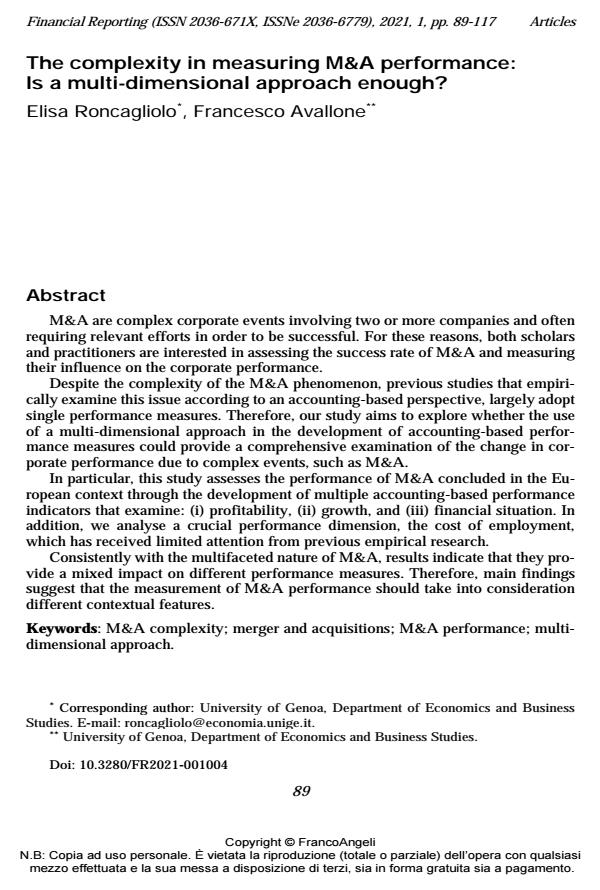The complexity in measuring M&A performance: Is a multi-dimensional approach enough?
Titolo Rivista FINANCIAL REPORTING
Autori/Curatori Elisa Roncagliolo, Francesco Avallone
Anno di pubblicazione 2021 Fascicolo 2021/1
Lingua Inglese Numero pagine 29 P. 89-117 Dimensione file 199 KB
DOI 10.3280/FR2021-001004
Il DOI è il codice a barre della proprietà intellettuale: per saperne di più
clicca qui
Qui sotto puoi vedere in anteprima la prima pagina di questo articolo.
Se questo articolo ti interessa, lo puoi acquistare (e scaricare in formato pdf) seguendo le facili indicazioni per acquistare il download credit. Acquista Download Credits per scaricare questo Articolo in formato PDF

FrancoAngeli è membro della Publishers International Linking Association, Inc (PILA)associazione indipendente e non profit per facilitare (attraverso i servizi tecnologici implementati da CrossRef.org) l’accesso degli studiosi ai contenuti digitali nelle pubblicazioni professionali e scientifiche
M&A are complex corporate events involving two or more companies and often requiring relevant efforts in order to be successful. For these reasons, both scholars and practitioners are interested in assessing the success rate of M&A and measuring their influence on the corporate performance. Despite the complexity of the M&A phenomenon, previous studies that empirically examine this issue according to an accounting-based perspective, largely adopt single performance measures. Therefore, our study aims to explore whether the use of a multi-dimensional approach in the development of accounting-based performance measures could provide a comprehensive examination of the change in corporate performance due to complex events, such as M&A. In particular, this study assesses the performance of M&A concluded in the European context through the development of multiple accounting-based performance indicators that examine: (i) profitability, (ii) growth, and (iii) financial situation. In addition, we analyse a crucial performance dimension, the cost of employment, which has received limited attention from previous empirical research. Consistently with the multifaceted nature of M&A, results indicate that they provide a mixed impact on different performance measures. Therefore, main findings suggest that the measurement of M&A performance should take into consideration different contextual features
Parole chiave:M&A complexity; merger and acquisitions; M&A performance; multidimensional approach.
Jel codes:G34, M41
- The role of conditional conservatism on acquirers' stock prices around M&A announcement Fiorenza Meucci, Annamaria Zampella, Gianluca Ginesti, Adele Caldarelli, in FINANCIAL REPORTING 1/2025 pp.149
DOI: 10.3280/fr202517552
Elisa Roncagliolo, Francesco Avallone, The complexity in measuring M&A performance: Is a multi-dimensional approach enough? in "FINANCIAL REPORTING" 1/2021, pp 89-117, DOI: 10.3280/FR2021-001004